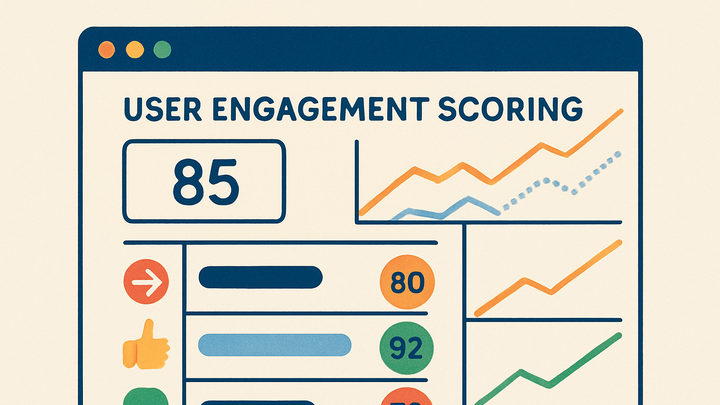Published on 2025-06-28T06:18:19Z
What is Engagement Scoring? Examples for Engagement Scoring.
Engagement scoring is a method of quantifying how users interact with your website or app. It assigns numerical values to user actions—such as pageviews, clicks, and form submissions—to create a composite score that measures overall engagement. Teams use these scores to identify high-value users, optimize content, and personalize experiences. This metric helps you move beyond simple counts of events, providing a clearer view of user behavior quality. Engagement scoring is especially valuable in analytics-driven industries, guiding decisions in marketing, product development, and customer retention strategies.
Engagement scoring
A method to quantify user interactions by assigning scores to actions, helping optimize engagement and tailor user experiences.
Understanding Engagement Scoring
This section breaks down the core concept of engagement scoring, explaining how it differs from traditional web analytics metrics and why it’s essential for measuring user value.
-
Definition
Engagement scoring assigns points to user actions based on their importance. Actions with higher business value—like completing a purchase—receive more points than lower-value actions like pageviews.
-
Interaction types
Includes events such as clicks, video plays, downloads, and form submissions.
-
Score aggregation
Individual action scores are summed to produce a composite engagement score per user or session.
-
-
Key metrics
Identifies the metrics commonly used to calculate engagement scores.
-
Session duration
Longer sessions typically indicate higher engagement.
-
Event completions
Critical actions like signups or purchases earn more weight.
-
Page depth
Number of pages viewed in a session.
-
Implementing Engagement Scoring
Guidance on setting up engagement scoring in popular analytics platforms, with examples using Google Analytics 4 and PlainSignal.
-
Using google analytics 4 (GA4)
GA4 natively tracks engagement metrics like engaged sessions and engagement rate. You can create custom event parameters and use BigQuery exports to calculate detailed scores.
-
Create custom events
Define events such as
video_startorform_submitand assign weights in your analysis layer. -
Bigquery analysis
Export GA4 data to BigQuery to run SQL queries that aggregate weighted events into a score.
-
-
Using PlainSignal
PlainSignal offers a privacy-focused, cookie-free approach to analytics and allows custom scoring through simple inline configuration.
-
Installation
Include the PlainSignal snippet on your site:
<link rel="preconnect" href="//eu.plainsignal.com/" crossorigin /> <script defer data-do="yourwebsitedomain.com" data-id="0GQV1xmtzQQ" data-api="//eu.plainsignal.com" src="//cdn.plainsignal.com/plainsignal-min.js"></script> -
Custom scoring
Use the
data-doattribute to tag and weight specific user actions directly in your HTML or JavaScript.
-
Benefits of Engagement Scoring
Outlines how engagement scoring drives better decision-making across marketing, product, and customer success functions.
-
User segmentation
Segment users based on engagement levels to tailor messaging and offers.
-
Content optimization
Identify high-engagement content to replicate success patterns.
-
Retention improvements
Focus on re-engaging users who have dropped below a desired score threshold.
Best Practices and Considerations
Key recommendations to ensure your engagement scoring model is accurate, fair, and aligned with business goals.
-
Define clear criteria
Choose actions and weights that reflect true business value.
-
Balance data privacy
Leverage cookie-free tools like PlainSignal to respect user privacy without sacrificing insights.
-
Regularly review weights
Adjust point assignments as user behavior and business priorities evolve.
